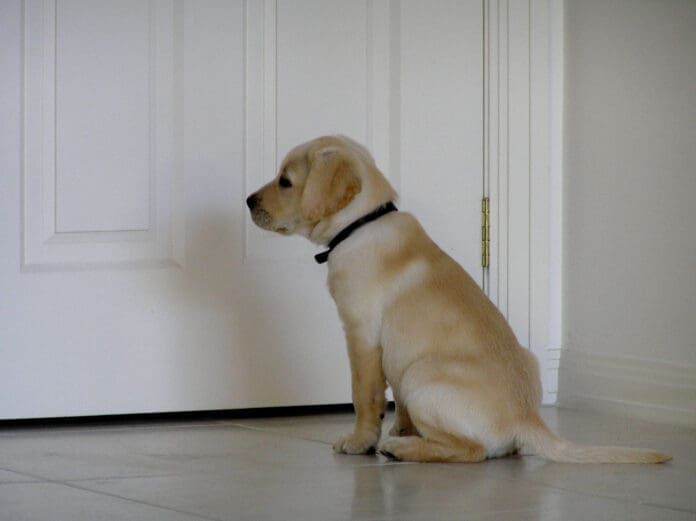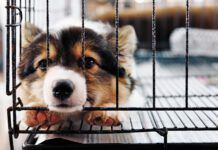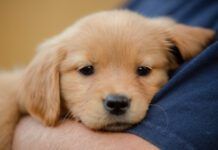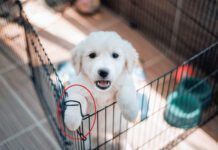House training your puppy is all about consistency, attention to detail, and taking advantage of your puppy’s natural behaviors. Most puppies are potty trained by six months of age, but this can vary depending on a number of factors.
Potty training is actually more about training you than it is about training your puppy. You have two goals:
- Read your puppy’s body language so you know when she needs to go outside.
- Be proactive to prevent accidents from happening in the first place so that your puppy quickly develops good habits.
Understanding Your Puppy’s Needs
Young puppies have very small bladders and are still developing muscle tone. Because of this, when they need to go, they go! And this happens frequently.
Puppies naturally want to keep their living space clean. However, for a puppy, your house is a big place. It will take time for your puppy to understand that first an entire room and then the whole house counts as their living space.
Key times that puppies frequently need to pee or poop include:
- After naps
- After meals
- When a play session starts to wind down
Your puppy is already able to tell you when he needs to pee or poop. The trick is you learning to recognize his signals, and then over time improving your communication with each other.
A Crate is Your Best Friend
Crates are the very best tool when house training a puppy. Even if you don’t intend to use a crate frequently throughout your dog’s life, crate training is a life skill that every dog should have for both their peace of mind and ours, and it makes house training much easier!
Choose a crate that is big enough for your puppy to comfortably lie down, but not much bigger. For large-breed puppies, you will need to increase the size of the crate as your puppy grows (some crates come with a divider so you can change up the space your puppy has over time). Why the small size? If your puppy has a large space at his disposal, it is very easy for him to choose one section of the area as his napping and playing space, and another corner as the peeing and pooping spot. Not what you want. You want the crate to be small enough that your puppy prefers to not pee or poop in there.
The crate should have a blanket or bed that is appropriate for the climate, and a couple of toys that your puppy can play with. I recommend feeding meals in the crate to help make it a positive place for your puppy.
Using a Crate at Night
Place the crate right next to your bed. This way your puppy knows you are close by, and you can even reach down with your hand for him to nuzzle. The other plus to having your puppy close is you can hear any fussing.
If your puppy wakes up in the middle of the night and needs to pee, he will fuss rather than make a mess in his crate. For some puppies this is just a little whining, while others may bark or scream. When you hear your puppy fussing, quickly either carry him outside or encourage him to run to the door and yard. Place him in the grass and praise when he pees or poops.
Once done with your little bathroom break, place your puppy back in his crate with a treat and go back to bed.
Tips:
- The first couple nights home with a new puppy may be challenging. This is normal, and your puppy will settle in to his new routine.
- Use a treat that takes a couple minutes to chew as a bedtime snack. This helps to encourage your puppy to settle down and calms him at bedtime.
- No playtime during midnight pee breaks. Some older puppies may try waking you up for a game of tug or chase—don’t give in. The rule is that when your puppy fusses, he gets a trip outside for a short walk, then back to bed.
- Stay calm, even when you’re exhausted (we’ve all been there). Your puppy is learning and growing, and these things can take time.
Using a Crate During the Day
As much as you are able, you will want to be watching your puppy directly and interacting with him (more on that later). But this is not always possible. Whether you are getting some work done, making dinner, running errands, or taking a nap, the crate will help you maintain house training criteria when you can’t be watching your pup every minute.
Set the crate up somewhere that you can hear and/or see your puppy. Give your puppy a treat or toy when putting him in the crate so he has something to do. Take him out for regular bathroom breaks—with puppies 8-12 weeks old, I like to do this every hour if possible. It can feel excessive, but bringing your puppy outside frequently gives him lots of opportunities to take care of business, reducing the risk of accidents in the house.
Listen for signs that your puppy is waking up from a nap or getting fussy, as these indicate that it is time to go outside.
As your puppy gets older and you get a feel for his schedule and bladder strength, you can gradually increase the amount of time between bathroom breaks. A general rule of thumb is that puppies can go one hour for each month of age—for example, a five-month-old puppy can go five hours without peeing. But this can vary between individual puppies.
Learn Your Puppy’s Signals
When you are able to keep an eye on your puppy, she can roam more freely. But remember your two goals—reading your puppy’s body language and being proactive to set your puppy up for success and prevent accidents.
Every puppy communicates in their own way, but there are common signals that a puppy needs a trip outside. Watch your puppy for one or more of these behaviors:
- Circling
- Wandering away from play
- Whining
If you see your puppy do one of these things or notice any other sudden change in behavior, take her outside to see if she needs to go.
When in Doubt—Go Out!
False alarms can be frustrating, but it is much better to take your puppy out when she doesn’t really need it than to cause her to have an accident.
Over time, your puppy will learn that she has the ability to “make” you take her outside. By responding to her subtle signals that she needs to pee or poop, you are giving those signals value and strengthening them over time.
One of my dogs has a particular whine and pace that he does when he really needs to go out. Another stares at me like she’s trying to fry my brains with her laser eyes. And the third gets my attention and then leads me to the door to ask to go out (yes, she has spoiled me!).
Praise for Good Habits
Praise and reward your puppy for peeing and pooping outside. Tell her what a brilliant and perfect puppy she is, and pet her or give her a treat. You can also play a little after she eliminates outside.
You are trying to build the pattern for her that the urge to eliminate means it is time to go outside, which is a really good thing!
How Long Does It Take to Potty Train a Puppy?
Six months of age is a rough ballpark for when your puppy should be fully housetrained. That said, some puppies are house trained as early as four months, while others may take a full year.
Young puppies will take longer to house train, while older puppies generally catch on quicker (plus they have better bladder control).
Small and toy breed puppies tend to take longer to house train because of their tiny bladders and small size.
Your puppy’s upbringing before coming to your house will also impact house training. If your puppy was in a really messy situation, he may not value cleanliness at first. And if your puppy has only eliminated on cement in a kennel run, he may be confused about the new rules about needing to eliminate on grass. Be patient.
How Long Can a Puppy Go Without Peeing?
As stated above, the general rule of thumb is that a puppy can go one hour for each month of age. So a three-month-old puppy can go three hours, a six-month-old puppy can go six hours, etc.
This can vary based on your individual puppy’s bladder strength and any extenuating factors, such as drinking a bunch of water after playing.
Overnight is the exception. Most 8-week-old puppies are capable of sleeping through the night but may not always, so keep the crate close so you will hear your puppy fuss if she needs to go out. But you do not need to set alarms every two hours for walks—as long as your puppy is resting, you can too.
Handling Long Stretches Between Walks
Despite our best efforts, sometimes we can’t stick to our puppy’s ideal potty break schedule. In these situations, set your puppy up with a larger space and a couple of pee pads to provide an okay place to go if she needs to.
Accidents Happen
Whole Dog Journal is reader-supported. If you purchase through links on our site we may earn a commission. Whole Dog Journal does not accept money for its food and product reviews.
No matter how awesome of a puppy mom or dad you are, sooner or later you’re going to slip up and your puppy will have an accident in the house. It’s okay! Here are some things to keep in mind:
- Your puppy isn’t a bad puppy. Poop (and pee) happens.
- Yelling won’t help. Your puppy has no idea why you’re yelling—all she knows is that you are being really scary.
- If you catch your puppy in the act, scoop her up and rush her outside, then praise for finishing the job in the yard.
- Try to identify what “went wrong.” Maybe your puppy stood up in a funny way and you weren’t quite sure it meant she needed to pee. Maybe you got too caught up in the World Cup and forgot that it was time for a trip outside.
- Nature’s Miracle is great stuff, and safe on most rugs and carpets. Clean messes up thoroughly using an enzymatic cleaner so that the area doesn’t have a residual smell.
Be patient with both your puppy and yourself through house training. Potty training a puppy is a process—you’ve got two different species learning to communicate with each other, and one of those beings is growing rapidly and having to relearn her body on a weekly basis.
If you stay consistent about taking your puppy outside frequently to set her up for success, praise for eliminating outside, and use a crate to help when your attention needs to be elsewhere, you and your puppy will get there!
Additional Tips
- Use baby gates or exercise pens to create smaller sections in your house. This gives your puppy a little more freedom during the day, but still keeps her partially confined and limits how far away from you she can get.
- Ask your puppy’s breeder if they litter box training the puppies or what material they used in the puppies’ bathroom area. For example, if your puppy is used to eliminating on wood chips, placing some wood chips in your yard can help clue your puppy in to that area being the designated bathroom spot.
- When taking a shower, bring your puppy in the bathroom! This can be a fun alternative to going in the crate, and keeps your puppy close enough you can make sure she isn’t getting into trouble.
- Housetraining will take longer if your puppy was raised in unsanitary conditions. Be proactive and take these puppies outside as often as possible so you can minimize accidents and maximize opportunities to praise for eliminating outside.
- Housetraining can take longer for small and toy breed puppies. These guys are just so little that they can’t fathom why it is a problem to poop in a corner of the living room—and their tiny bladders don’t help either. Be proactive about taking these puppies outside frequently, and use crates and baby gates to limit your puppy’s space when you can’t watch her closely.
- If your puppy had been doing well with housetraining but is suddenly peeing in the house frequently, take a urine sample to your veterinarian to have it checked for a UTI.
- If your puppy has diarrhea for more than 24 hours or if at any point she is both vomiting and having diarrhea, call your veterinarian. Puppies can get dehydrated rapidly and she may need medical care.






